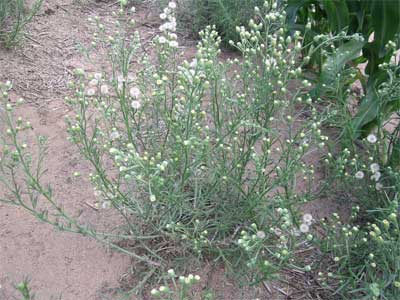Western Australia
January 7, 2009
 |
|
Growers who have paddocks with even infestations of
Flaxleaf Fleabane plants (young growth habit depicted)
are urged to contact Dr Sally Peltzer of DAFWA who is
seeking trial sites for a GRDC supported study in 2009. |
| |
 |
|
A
mature Flaxleaf Fleabane plant showing the candelabra
growth form. |
A hairy, candelabra-shaped plant
up to one metre tall and a member of the daisy family is
emerging as a weed of broadacre crops on Western Australia’s
south coast.
The distinctive shape of Flaxleaf fleabane (Conyza
bonariensis) is due to the stem, which branches below each
pyramid of flowers.
Grains Research and Development
Corporation (GRDC) supported trials investigating its
lifecycle and potential control options will begin in 2009.
Dr Rohan Rainbow, GRDC Manager of Crop Protection, says the
weed, already a problem in southern Queensland and northern NSW,
has a number of characteristics contributing to its emergence.
“A mature Flaxleaf fleabane plant produces an average of 110,000
seeds and fresh seeds are not dormant at maturity, so they can
germinate with favourable temperature and moisture conditions.
“The seed heads are a compact five to ten millimetres across and
each seed has a parachute of fine hairs, allowing easy dispersal
by wind.
“In addition, large tap roots up to 35 centimetres aid survival
over summer,” Dr Rainbow says.
Dr Rainbow indicated fleabane seeds only emerged from or near
the soil surface and in WA the seeds often germinated under
crops in spring or at harvest.
Once crops are harvested, a lack of competition, combined with
summer rain, can cause rapid growth of fleabane.
GRDC supported weed specialist, Dr Sally Peltzer of the
Department of Agriculture and Food WA (DAFWA), wants access to
suitable trial sites of at least half a hectare, with even
infestations.
Growers able to offer trial sites should contact Dr Peltzer at
DAFWA’s Albany office, Tel 9892 8504.
She says effective fleabane chemical control is possible by
targeting early, actively growing plants before stem elongation.
“In WA, these early control windows often occur before harvest
or at swathing, making options difficult. The trial sites will
focus on the control of large fleabane in stubble after harvest.
“Grazing can also be a useful control method, but it’s important
to let sheep into infested paddocks when the plants are young,”
Dr Peltzer says.
Flaxleaf fleabane is a weed of pasture and cropped paddocks, but
appears to occur more frequently in recently cropped areas.
Dr Peltzer says there is no confirmed herbicide resistance in
fleabane populations in Australia, but overseas reports indicate
biotypes of fleabane have become resistant to a range of
herbicides from different mode of action groups, including
glyphosate.
“This indicates growers should use an integrated weed management
strategy, combining chemical and non-chemical control.”
The factsheet ‘On farm solutions: Management of Flaxleaf
fleabane’ is available for viewing and downloading from
www.grdc.com.au/weedlinks |
|
|
|
The factsheet
On farm solutions: Management
of Flaxleaf fleabane
is available for viewing and
downloading from
www.grdc.com.au/weedlinks |
|